#and if they manage to get it published Ill obviously by credited !!
Explore tagged Tumblr posts
Text
I'm in a zoom call with the archivist of [redacted] and I might be an author/collaborator for a published book in a few years... crazy...
#they found a uh citizen book and Im on the team transcribing it!#well I already transcribed 3 pages and now I'm on the team to hopefully transcribe the whole thing#and if they manage to get it published Ill obviously by credited !!#I also got a certificate by the archive for the 3 pages I done ^_^ so thats cool for my resume considering ive been in uni for only 6 month#OH also VIENNA is interested in the project as well. thats crazy#.txt#akademija
7 notes
·
View notes
Text
First post
Hi Tumblypoos!
My name is Tate and I've decided to start a blog dedicated to my academic writing and shit like that. I wanted a place to publish publicly my writings because I'm an attention whore and also because what is the point of writing a bunch of pretentious academic shit without other people to read it and think you're stupid and/or argue with you? I wanted to start a wordpress, I think I'm going to still, but I'm way more familiar with tumblr.
As a mentally ill individual, I've been using tumblr since 2015. I haven't been on for a few years, but I'm back because this is a familiar environment and I know I can swear and basically say whatever I want because way worse has, and will, be said on here. As much as I would like to only be strictly feral here, I think I should have some type of decorum, so I will not be indulging on my personal life and shit talking those I hate, that I know personally. Public figures are fair game. As a tumblr veteran, most, if not all, of my personality and sense of humor are derived from this website, with that being said: I am 25, so essentially geriatric when it comes to the niche culture on here so if what I write comes across as buzzfeed millennial in any way I will be very insecure, and also probably book an appointment to have myself put down. Unfortunately, this is my inner monologue and I fear it may be too late anyway.
I'm very slowly pursuing history and english literature degrees, I think they're fun (hence the hobby blog) and wanted to go to school for something I thought was fun. I'd like to go back for human resource management and tourism and hospitality. I can defer my loans longer :) and I think I would have a wider range of job opportunities in more interesting places. I love Appalachia, which is why my blog theme is centered on that region, the user name, my literal living identity, etc. etc., but I don't want to never not leave, and I would have a better appreciation of it when I come back.
I live very close to the midwest, so in driving through (to buy my weed in Michigan (which I smoke all in Michigan before going home)) I like to compare and contrast the differences between where I live, and how people in .. Ohio .. live, the differences between western and Eastern Pennsylvania, architectural variation across the East Coast. Shit like that. Its all very niche and localized because I've never been anywhere else, and I don't frankly care that much about the cultures of the rest of the US like I do the Midwest, Appalachia & Southern states. They're important, they do have influence on these regions, obviously, and I will give credit where its due but I'm not here for them.
My mother's family is from Ohio. This portion of my family derives from Ireland, Germany, and Czech/Slovak regions. My father's family is Italian. These things are a part of why I do what I do, I think its important to the hard work and perseverance of all of my blue collar family members and what they did to get me where I am today. With the way the US is set up, after a certain point, those cultures were diminished and erased, I know nothing about any of them and so I hope that in this way I will be able to better know and understand what they went through, and who they were.
Furthermore, I love food, clothing, and cultural trends. I firmly believe I can sus out someone's vibe by the shoes they're wearing, and I think that its something that comes with practice, experience and observation. I'm a restaurant industry person, and a food person in general. I'm working on a West Virginian themed cook book, that I can start on again when the spring rolls around because there will be edible things out and about. Not animals, I'm not killing animals. So anticipate recipes and shit like that. I am also a movie snob in the worst way possible, I believe every movie I like and them all together is the best movie curation ever, and those that I don't like are bad for good reason. This is, obviously, not true, but its fun to feel like it is and I'm not ashamed to admit that.
I overuse commas, and I will not apologize or adjust to that. They make sense to me in my head and I am the most important person to me, especially here.
Love u tumblypoos xoxo
Tate :) <3
#culture#fashion#food#clothes#appalachia#west virginia#pennsylvania#ohio#kentucky#mississippi#virginia#north carolina#maryland#michigan#illinois
1 note
·
View note
Text
New Post has been published on Paula's Bookkeeping Solutions
New Post has been published on https://scottsdalebookkeepingservice.com/great-advice-for-people-looking-to-manage-their-finances/
Great Advice For People Looking To Manage Their Finances


Personal finances will be out of control if you do not have a method in place of tracking your budget and being mindful about your spending. If you are struggling with your finances, you need some good advice on how to get them back in order. This article contains guidelines for taking back control of your financial situation and staying more organized.
Success starts with managing money well. Capital that you invest should be well protected. You will see a return on your investments by managing profits. You should always invest the same percentage of your profit.
Do not sell if it is not the right time for you. If you are getting money from one stock more than another, let that one stay. If you have stocks in your portfolio that are not performing well, you may wish to change them up a bit.
Do not believe credit repair has the guaranteed success to improve your history. Most companies try to embellish their abilities to make you feel that they will be able to repair your credit history. Everyone’s credit situation is different, so to say they have the one trick to remedy all credit issues is obviously a lie. It’s simply not a case of ‘one size fits all’ when it comes to credit repairs, so there can be no guarantee of success.
To save both money and time, buy bulk quantities of lean protein. In most instances, purchasing items in bulk is the most budget-friendly option. It is a time saver to spend time in one day to use this meat and set aside some for a meal each day.
Most electronics that have defects will show them within the manufacturer’s warranty for the product. The only one who benefits from an extended warranty is the warranty company, not you.
If you want a good credit report, you should use between two and four credit cards. If you only have one card, your credit score will rise, but slowly. If you have more than four, it is an indication that you have difficulty dealing with your finances. Stick with two to three cards, and be mindful of how you use them in order to build a solid credit history.
When it comes to your personal finances, you should always practice patience. It is very common for many people to go out and buy the latest electronics immediately. However, just by waiting a little while, you will see the price drop significantly. This opens up your budget to buy more things.
The biggest purchase in the budget for your household is the purchase of a home or a new car. Payments and interest rates are what will be a huge part of your expense each month. You can pay these items faster simply with an additional payment every year, or you could make use of your tax refunds for paying the balance.
Health Insurance
Make sure you have adequate health insurance coverage. No matter who you are, it’s possible to get sick at any time. For this reason, it is vital to have good health insurance. If an illness comes up suddenly, you could be left with thousands of dollars in medical bills. You will have a big issue if you cannot carry health insurance.
If you are having difficulties paying off a credit card, you should stop charging it. Eliminate any unnecessary expenses and find another payment method to avoid maxing out your credit cards Finish paying off your balance before using the card again, and then try to pay your credit card balance in full every month to avoid future troubles.
Pay yourself first by making a savings deposit from each check your receive, before you spend any of that money. It is easier to save money every week rather than waiting to see what you have left when the month is over. Since the money is not available, it will make it simpler to stick to your budget.
Quantity purchases at grocery stores during a sale is only worthwhile if you are going to use all of the products you buy. Even if the items you stock up on are ones you regularly use, you have to be able to consume them all before their expiration dates. Shop for bargains, and don’t be afraid to buy 10 pounds of peanut butter if your family loves it, but use common sense.
Personal Finances
Don’t let your personal finances get to you, clear your head, and realize it is time for you to tackle the issues. The article has provided you with the information you need to get on the right track, so apply this information to your personal finances and you will make a difference.
Learn More about What we do.
0 notes
Text
DC House of Horror #1, Part Two (AKA A Review of Netflix’s The Mist)
It looks like Batman is fucking Flash while Flash fucks Green Lantern while Green Lantern, covered in semen, jerks off a candle.
Here, a woman smells her fingers for some mysterious and sexy reason.
I'm sorry for that previous caption! The only reason I said it was probably sexy was because she is a woman and I'm objectifying her. I smell my fingers for decidedly non-sexy reasons all the time! If anybody is interested in my life away from my blog, you can visit me intellectually debating the guys at the weird science comic book review blog on their review of Deadman #1. I'd forgotten that they were supposed to be my nemeses! But I remembered! Oh how I remembered! The woman smelling her fingers has been possessed by Wonder Woman because she took part in a Milton Bradly sponsored seance.
See?! You probably thought I was being facetious about the chewing testicles part! It's a known fact!
It's too bad I just scanned two images so closely together because the next page contains a nipple and a bare butt! The nipple is in shadow but you can still see the shape of it! I don't know why I'm using an exclamation point for that revelation. Back in the pre-Internet days, it would have been a glorious find for a young kid. But now, it's as tame as if the panel depicted a basket of kittens. The girl possessed by Wonder Woman kills all of her friends and everybody she meets before getting home and killing her abusive father. She also says a bunch of stuff in Greek. I bet she's saying things like, "I'm here to kick ass and chew testicles! Mmm! So good!" Nope. I was wrong. The first thing Wonder Woman says after possessing the girl is "Where am I, witches?" Then she kills the witches. Later after her killing the girl's dad, she says, "The world of man is Hell. It is going to be a glorious war." Man's World Rating: Are these stories horrific? I guess so. Imagine if Superman were a confused toddler scared out of his wits when he arrived on Earth? He probably would kill everybody by accident in his fits of terror. And Wonder Woman suddenly coming to man's world without any context except what she's been told about why the Amazons can't leave the island? She'd be ready for some serious clean up! And she only killed the women at the beginning because they were obviously witches. Some women, you just can't trust. So you get what we had here in this story. I don't like it any more than you women.
1 note
·
View note
Text
Journal of Gerontology and Geriatric Medicine-JuniperPublishers

Editorial
All around the world geriatric population is increasing. This is accompanied by its unique problems including issues of senescence and frailty, and at times complicated by multimorbidities [1]. Against the backdrop of increasing numbers of elderly population and their unmet and rising medical requirements with stagnant and dwindling resources at many places around the globe, it's about time that we start to explore creditable newer ideas, concepts and research that are aimed towards helping geriatric population [1]. Having to deal with long term multi-morbidities is as such quite challenging, and the challenge just increases a bit more with the progress of aging. There can be some associated morbidities which may at times get superimposed by a few psychosocial issues as well. Shouldn't our endeavor be to help the elderly achieve graceful aging?
From the perspective of longevity, no one amongst the elderly seems to be looking forward to a life of 1000 years; not yet. To be sure, just try taking views from any youth about their own aging, when they do start getting old. Probably the views would be revealing, and with my experience I dare say that I would expect a prompt response from most of the young and middle aged people when asked this question responding by replying that they would be trying in their own ways to keep healthy till their last breath, and avoid becoming bed-ridden or dependent on anyone when they get old. With the experience gained, for me the aged are no different, and while most of them will never be fearing death, and will have no desire to prolong their lives, they too probably would say that they do not want to fall ill, become bed-ridden, or disabled, and if they had their choice they would never like to become dependent on anyone. Their efforts are therefore directed to stay as fit as possible [2].
In the developing world, it's not that the aged are anyway different. But here, since ages, much reliance was placed on the family structure for support and care, but now that the family structure is disintegrating, the old and infirm are now worried because there is no one to look after them as their health deteriorates [2]. Hence they probably have a desire to remain healthy for as long as possible, for the simple reason of being able to fend for themselves for as long as they can [2]. Fortunately, those who have managed their health well, taken appropriate and timely care of their health problems, and those who are adequately insured medically may not have any such issues or apprehensions.
It should be quite heartening to note that the world is definitely taking steps to alleviate the problems of the old age. Scientists around the world are searching for clues regarding healthy aging [3]. In the elderly population there is permanent decrease of functional capacity, gradual emergence of various diseases leading to the wider multi-morbidity and increased problems in the social sphere, which can develop frailty and social dependency [4]. The authors have emphasized the need of awareness of the problem so that they could understand and cope with this absolutely new reality [4]. Multi-morbidity and the consequent poly-pharmacy are indeed another big challenges globally, that is being appropriately understood and evaluated [5-9].
Therefore it's time that the plight and predicaments of the elderly population should be evaluated and taken into account on an urgent basis. It is no secret that at many places around the globe, the available resources and medical facilities for the elderly population are getting overwhelmed due to increasing demands and unmet needs. Fragmentation of care is also some concern and there are long waiting periods [10]. Some of the aged may be turning despondent and losing hopes due to multi-morbidities, poly-pharmacies, inequities in appropriate and readily available geriatric care, which as such is getting more fragmented with either actual or perceived limitations and inadequacies of geriatricians, and the effect of super-specializations. No doubt, there will always be a requirement of all other specialties, but a time has come where there is a need for Geriatricians to brace up for resolving more, and to refer less [10].
For this to happen, firstly of the governments, policy makers, administrators, medical fraternity and world medical bodies, NGOs, community leaders, etc, must all get together and decide about establishing the new norms, scope, up gradation of knowledge, skills and expertise of a geriatrician that become well suited for resolving more and referring less. For this there is a requirement for adding additional knowledge, skills, competence, and expertise. Obviously the medical curriculum during graduation and post graduation has to be suitably upgraded so as to pave way for a new Geriatrician, who is knowledgeable, expert in assessing and dealing with geriatric problems and challenges. With new evidences surfacing regularly, maybe there is a need to refresh our understanding of the geriatric problems regularly. The presentations could be diverse, intertwined and/or mixed, and perhaps not as straight as are met in other age groups. There could be many independent or correlated underlying problems as given below (Figure 1).
Hence, this will require a geriatrician to be more meticulous and alert right from the point when an elderly patient walks in or is brought in for consultation. Observations must be meticulous and thorough, with some structuring that helps in reaching out for a detailed of history and clinical examination. Regular individualized and structured reviews and follow ups will be equally important. Besides senility, there can be many other factors which might play up for which we need to be alert, like underreporting of illness, impairment of homeostasis, vulnerability to various stresses, etc. Some other points that need to be considered are given in (Figure 2).
As Geriatricians we need to be vigilant and look out for the transition, and also screen and manage risk factors with the ultimate aim of helping them in aging gracefully. There could also be a need for environmental facilitation with all proactive and preventive measures in order to maintain their continued independence, fitness levels, and competence, which might be found getting deteriorated with time. It is perhaps not so difficult to understand that one set of management techniques would not be meeting all the challenges at all times, and therefore the treatment and management will have to be individualized and tailored for better outcomes [11]. Principles of rehabilitation will also have to be suitably modified for indevidual cases.Assessing & recording fitness levels should become a routine, and can be undertaken by such simple non-invasive tests like:
Katz Index of Independence in Activities of Daily Living
Harvard Step Test
Assessment of V2 MAX
Hand grasp strength assessment by hand dynamometer
Mini mental state examination
Pulmonary function test
Vision test
Whispering test with masking
This is the first issue of this new journal, the Open Access Journal of Gerontology & Geriatric Medicine (OAJGGM). I wish it becomes another torch bearer the world over in the days to come, for the gerontologists and specialists in geriatric medicine. As an invitee for writing for the very first issue, and a member of the editorial board, it would certainly be my delight I would like to see the journal taking on the challenge of overcoming and managing all accompanying morbidities and poly-pharmacy being addressed from a newer perspective, while sifting through the research that has already been done for the geriatric population and at the same time promoting and gaining from recent researches.
Whatever fears and apprehensions the elderly might have, will possibly be laid to rest by meaningful dialogue about preventive and proactive actions that they would be advised to take, based on not what they hear and see but on actual scientific reasoning and facts. Among other issues involved in the editorial policy, it would be a reasonably good and thoughtful effort if this journal also pitches for giving out vetted comprehensive health bulletins, thereby taking care for the geriatric population's needs as well for accurate and doable information, recommending only indisputable preventive and proactive measures as the need of the day for the elderly and their care givers. Isn’t the ultimate aim is to improve the quality of life of the elderly, and provide adequate respite from morbidities?
Finally, in today's world, the direction of future research needs to be carefully steered, and not left to or overtaken by some vested groups to model research. Costly procedures, investigations, medicines, etc, have raised the costs of management. There is surely a need to take a second look at all that is being done or recommended for the elderly patients. Recently there was a study that has revealed that medical errors are the third leading cause of death in the USA [12]. Therefore unnecessary tests, unnecessary procedures, unnecessary medicines, etc, will have to be restrained. Possibly in the free and competitive market, it is all about selling an idea, perhaps, and patients will automatically follow the 'flow'. It is up to the society, the law makers, and the keepers of the society as also the medical and scientific fraternities to decide whether it is OK to be going with the flow every time. The 'evidence based medicine' also comes to decide the 'evidence' from only the researches that have taken place and have been found published. What about the other 'evidence' that has as yet not been researched in the proper scientific manner, having come about unintentionally,half-heartedly, or maybe accidentally, and for which there are no takers as yet and no one cares? [13].
To read more articles in Journal of Gerontology & Geriatric Medicine
Please Click on: https://juniperpublishers.com/oajggm/index.php
For more Open Access Journals in Juniper Publishers
Click on: https://juniperpublishers.com/journals.php
0 notes
Link
Big data, as its proponents have been saying for nearly a decade now, can bring big benefits: advertisements focused on what you actually want to buy, smart cars that can help you avoid collisions or call for an ambulance if you happen to get in one anyway, wearable or implantable devices that can monitor your health and notify your doctor if something is going wrong.
It can also lead to big privacy problems. By now it is glaringly obvious that when people generate thousands of data points every day — where they go, who they communicate with, what they read and write, what they buy, what they eat, what they watch, how much they exercise, how much they sleep and more — they are vulnerable to exposure in ways unimaginable a generation ago.
It is just as obvious that such detailed information, in the hands of marketers, financial institutions, employers and government, can affect everything from relationships to getting a job, and from qualifying for a loan to even getting on a plane. While there have been multiple expressions of concern from privacy advocates and government, there has been little action to improve privacy protections in the online, always connected world.
It was more than five years ago that the Obama administration published a blueprint for what it termed a Consumer Privacy Bill of Rights (CPBR), in February 2012. That document declared that, “the consumer privacy data framework in the U.S. is, in fact, strong … (but it) lacks two elements: A clear statement of basic privacy principles that apply to the commercial world, and a sustained commitment of all stakeholders to address consumer data privacy issues as they arise from advances in technologies and business models.”
Three years later, in February 2015, that blueprint became proposed legislation by the same name, but it was immediately attacked, both by industry groups, who says it would impose “burdensome” regulations, and by privacy advocates, who says it was riddled with loopholes. It never made it to a vote.
The CPBR declaration that the, “consumer privacy data framework in the U.S. is, in fact, strong …” ironically came about a year before revelations by former NSA contractor Edward Snowden that the U.S. government was, in fact, spying on its citizens.
Beyond that, government hasn’t been able to agree on other privacy initiatives. The so-called broadband privacy rules issued by the Federal Communications Commission (FCC) just before the 2016 election, which would have limited data collection by Internet service providers (ISPs), were repealed by Congress in March, before they took effect.
Susan Grant, director of consumer protection and privacy at the Consumer Federation of America (CFA), called it “a terrible setback,” and says it would allow ISPs, “to spy on their customers and sell their data without consent.” Others, however, have argued that putting limits on ISPs would still leave other online giants like Google free to collect and sell the data they collect, and consumers would see few, if any, benefits.
Given all that, it should be no surprise that experts say privacy risks are even more intense, and the challenges to protect privacy have become even more complicated. Organizations like the CFA, the Electronic Privacy Information Center (EPIC) and the Center for Democracy and Technology (CDT), along with individual advocates like Rebecca Herold, CEO of The Privacy Professor, have enumerated multiple ways that big data analytics, and resulting automated decision-making, can invade the personal privacy of individuals. They include:
1. Discrimination
EPIC declared more than three years ago, in comments to the U.S. Office of Science and Technology Policy that, “The use of predictive analytics by the public and private sector … can now be used by the government and companies to make determinations about our ability to fly, to obtain a job, a clearance or a credit card. The use of our associations in predictive analytics to make decisions that have a negative impact on individuals directly inhibits freedom of association.”
Since then, things have gotten worse, privacy advocates say. While discrimination is illegal, automated decision-making makes it more difficult to prove. “Big data algorithms have matured significantly over the past several years, along with the increasing flood of data from the nascent internet of things, and the ability to analyze these data using variants of artificial intelligence." says Edward McNicholas, global co-leader of the Privacy, Data Security, and Information Law Practice at Sidley Austin LLP. “But despite this technological growth, the legal protections have not advanced materially.”
“I think the discussion around big data has moved beyond mere accusations of discrimination to larger concerns about automated decision-making,” says Joseph Jerome, policy counsel at the CDT, who noted that it has been used, “to direct calls at call service centers, evaluate and fire teachers, and even predict recidivism.”
Herold has been saying for years that big data analytics can make discrimination essentially “automated,” and therefore more difficult to detect or prove. She says that is true, “in more ways than ever” today. “Big data analytics coupled with internet of things (IoT) data will be — and has already been — able to identify health problems and genetic details of individuals that those individuals didn’t even know themselves,” she says.
McNicholas believes, “the most significant risk is that it is used to conceal discrimination based on illicit criteria, and to justify the disparate impact of decisions on vulnerable populations.”
2. An embarrassment of breaches
By now, after catastrophic data breaches at multiple retailers like Target and Home Depot, restaurant chains like P.F. Chang’s, online marketplaces like eBay, the federal Office of Personnel Management that exposed the personal information of 22 million current and former federal employees, universities, and online services giants like Yahoo, public awareness about credit card fraud and identity theft is probably at an all-time high.
Unfortunately, the risks remain just as high, especially given the reality that billions of IoT devices in everything from household appliances to cars, remain rampantly insecure, as encryption and security guru Bruce Schneier, CTO at IBM Resilient, frequently observes in his personal blog.
3. Goodbye anonymity
It is increasingly difficult to do much of anything in modern life, “without having your identity associated with it,” Herold says. She says even de-identified data does not necessarily remove privacy risks. “The standards used even just a year or two ago are no longer sufficient. Organizations that want to anonymize data to then use it for other purposes are going to find it increasingly difficult. “It will soon become almost impossible to effectively anonymize data in a way that the associated individuals cannot be re-identified,” she says.
Besides being vulnerable to breaches, IoT device are a massive data collection engine of users’ most personal information. “Individuals are paying for smart devices, and the manufacturers can change their privacy terms at a moment's notice,” Jerome says. “It's one thing to tell a user to stop using a web service; it's another to tell them to unplug their smart TV or disconnect their connected car.”
4. Government exemptions
According to EPIC, “Americans are in more government databases than ever,” including that of the FBI, which collects personally identifiable information (PII) including name, any aliases, race, sex, date and place of birth, Social Security number, passport and driver’s license numbers, address, telephone numbers, photographs, fingerprints, financial information like bank accounts, and employment and business information.
Yet, “incredibly, the agency has exempted itself from Privacy Act (of 1974) requirements that the FBI maintain only, ‘accurate, relevant, timely and complete’ personal records,” along with other safeguards of that information required by the Privacy Act, EPIC says. The NSA also opened a storage facility in Bluffdale, Utah, in 2014 that is reportedly capable of storing 12 zettabytes of data — a single zettabyte is the amount of information it would take 750 billion DVDs to store.
While there have been assurances, including from former President Obama, that government is “not listening to your phone calls or reading your emails,” that obviously ducks the question of whether government is storing them.
5. Your data gets brokered
Numerous companies collect and sell consumer data that are used to profile individuals, without much control or limits. There was the famous case of companies beginning to market products to a pregnant woman before she had told others in her family, thanks to automated decision-making. The same can be true of things like sexual orientation or an illness like cancer.
“Since 2014, data brokers have been having a field day in selling all the data they can scoop up from anywhere they can find it on the internet. And there are few — none explicit that I know of — legal protections for involved individuals,” Herold says. “This practice is going to increase, unfettered, until privacy laws restricting such use are enacted. There is also little or no accountability or even guarantees that the information is accurate.
Where do we go from here?
Those are not the only risks, and there is no way to eliminate them. But there are ways to limit them. One, according to Jerome, is to use big data analytics for good — to expose problems. “In many respects, big data is helping us make better, fairer decisions,” he says, noting that it can be, “a powerful tool to empower users and to fight discrimination. More data can be used to show where something is being done in a discriminatory way. Traditionally, one of the biggest problems in uncovering discrimination is a lack of data,” he says.
There is general agreement among advocates that Congress needs to pass a version of the CPBR, which called for consumer rights to include:
Individual control over what personal data companies collect from them and how they use it.
Transparency, or easily understandable and accessible information about privacy and security practices.
The collection, use and disclosure of personal data to be done in ways that are consistent with the context in which consumers provide the data.
Security and responsible handling of personal data.
Access to their personal data in usable formats, with the power to correct errors.
Reasonable limits on the personal data that companies collect and retain.
McNicholas says that “transparency” should include an overhaul of “privacy policies,” which are so dense and filled with legalese that almost nobody reads them. “Telling consumers to read privacy policies and exercise opt-out rights seems to be a solution better suited to last century,” he says. “Consumer privacy must shift to consumer-centric, where consumers have real control over their information."
Jerome agrees. “I certainly don't think we can expect consumers to read privacy policies. That's madness. What we should expect are better and more controls. It's a good thing that users can review and delete their Echo recordings. It's great that Twitter allows users to toggle all sorts of personalization and see who has targeted them,” he says. “But ultimately, if individuals aren't given more options over collection and sharing, we're going to have serious issues about our personal autonomy.”
Given the contentious atmosphere in Congress, there is little chance of something resembling the CPBR being passed anytime soon. That doesn’t mean consumers are defenseless, however. What can they do?
Jerome says even if users don’t read an entire policy, they should, “still take a moment before clicking ‘OK’ to consider why and with whom they're sharing their information. A recent study suggested that individuals would give up sensitive information about themselves in exchange for homemade cookies.”
Herold offers several other individual measures to lower your privacy risks:
Quit sharing so much on social media. “If you only have a few people you want to see photos or videos, then send directly to them instead of posting where many can access them,” she says.
Don’t provide information to businesses or other organizations that are not necessary for the purposes for which you’re doing business with them. Unless they really need your address and phone number, don’t give it to them.
Use an anonymous browser, like Hotspot Shield or Tor (The Onion Router) when visiting sites that might yield information that could cause people to draw inaccurate conclusions about you.
Ask others not to share information online about you without your knowledge. “It may feel awkward, but you need to do it,” she says, adding that the hard truth is that consumers need to protect themselves because nobody else will be doing it for them.
Regarding legislation, she says she has not heard about any other drafts of the CPBR in the works, “and I quite frankly do not expect to see anything in the next four years that will improve consumer privacy; Indeed, I expect to see government protections deteriorate. “I hope I am wrong,” she says.
5 notes
·
View notes
Text
Lucy the Fight Manager
S5;E20 ~ February 20, 1967
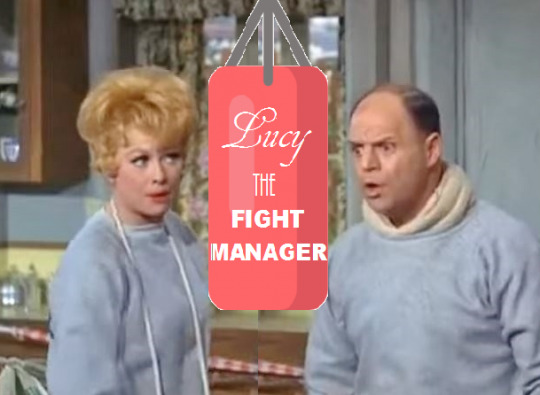

Synopsis
When Mr. Mooney has an argument with his wife, he orders flowers that are delivered by ex-prize fighter Eddie Rickles (Don Rickles). Eddie wants to buy a flower shop that will cost $3,000. When Mr. Mooney won't loan it to him, Lucy is determined to get him back in the ring to earn it.
Regular Cast
Lucille Ball (Lucy Carmichael), Gale Gordon (Theodore J. Mooney)
Roy Roberts (Mr. Cheever) and Mary Jane Croft (Mary Jane Lewis) do not appear in this episode, although Lucy does have a phone conversation with Mary Jane.
Guest Cast
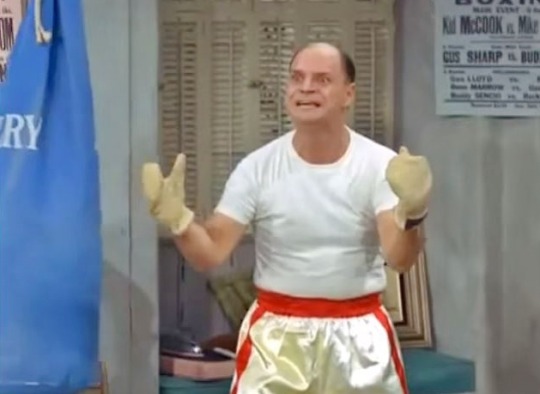
Don Rickles (Eddie Rickles) worked as a stand-up comic in nightclubs for nearly 20 years before making his film debut in 1958. Rickles was known as an insult comic and became a staple of Hollywood roasts. This is his first and last acting appearance with Lucille Ball, but would be seen with her on variety shows and specials through 1988. Rickles was the voice of Mr. Potato Head in the animated Toy Story franchise. e died in April 2017 at age 90.
Eddie is a former boxer now working as a delivery boy for Finley's Florist, which he wants to buy from Mr. Finley.
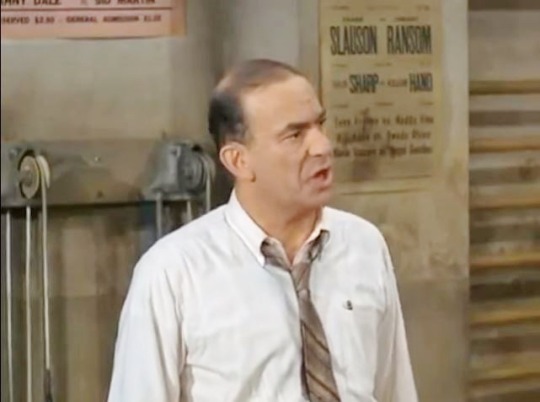
Cliff Norton (Ike, Sonny Shaw's Manager) makes the second of his two appearances on “The Lucy Show,” returning for three episodes of “Here’s Lucy.” He did a 1972 episode of “The Don Rickles Show.”
The character is never referred to by name in the dialogue.

Lewis Charles (Nick, above left) was seen in eleven Broadway plays between 1939 and 1947. In Hollywood, he is credited with over 160 films and TV shows. This is his only appearance with Lucille Ball.
The character is obviously supposed to be a mobster. He bets on Sonny Shaw and tells his trainer that he'd better win.
Stanley Adams (Louie, Sonny Shaw's Trainer, above right) makes the first of his three appearances on “The Lucy Show.” He was also seen with Lucille Ball in Critic's Choice (1963). In 1960, he was seen with Don Rickles in the film The Rat Race.

Bruce Mars (Sonny Shaw, a Young Prize Fighter) makes his only appearance on the series but returns the following year for an episode of “Here's Lucy.”
Mars has no dialogue, but he looks good in his boxing trunks! He shows more skin than has been seen before on “The Lucy Show.”

Sonny's ‘Tomato’ and others at the gym go uncredited.

This is the only episode written by Ronald Axe and Les Roberts. The pair also wrote an episode of “The Andy Griffith Show” (filmed at Desilu) that aired earlier in February 1967. “The Lucy Show” was the lead-in to “The Andy Griffith Show” on CBS's Monday night primetime schedule.

This is one of more than 30 episodes of “The Lucy Show” that is in the public domain and not under copyright. Because of this, it appears on many low-quality, low-priced videos.
While most actors got to use their own first names on the series (Lucy, Mary Jane, Mel Torme, Joan Blondell) Don Rickles is called Eddie, but uses his real surname. This is a rare example of Rickles doing scripted comedy NOT based on his brand of insult humor.
Stand-up comic Don Rickles made quite a name for himself as a sitcom guest star at this time. Lucille Ball reportedly had a hard time working with him because she never knew when he was kidding and when he wasn't.

The episode opens with Mr. Mooney on the telephone with his wife Irma. The character is often mentioned on the series, but never seen. Later in the episode, we learn that Irma is in charge of the Flower Show and wants to hire Eddie. The name ‘Irma’ was doubtless chosen for its association with the film, radio and television series “My Friend Irma” which starred Gale Gordon’s mother, Gloria Gordon, who died in 1962, the same year “The Lucy Show” began.
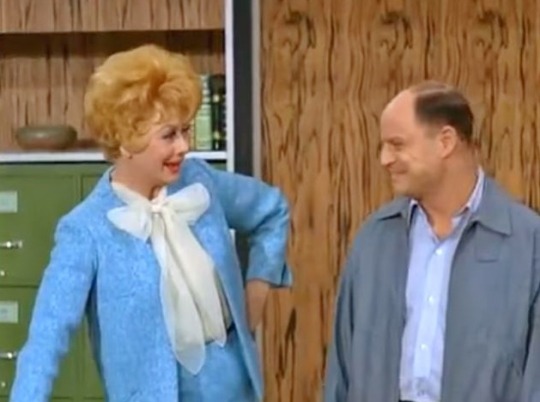
Lucy says she likes flowers because she used to live over a funeral parlor, although where and when we never find out!

Mr. Mooney says he saw Eddie Rickles knock out Joey Mitchell at Madison Square Garden in 1962. Although there was a real professional boxer named Joey Mitchell, his career began and ended in 1923 and ever got anywhere near Madison Square Garden! But Lucy Ricardo did, when she performed in “Lucy Goes to a Rodeo” (ILL S5;E8) in 1955.

Mr. Mooney says former baseball players generally open bowling alleys and boxers open saloons. Eddie wants to open a flower shop. Mr. Mooney may have been thinking of Jackie Tavener (1897-1969), who was a professional baseball player from 1921 to 1934 and later was the proprietor of a bowling alley in Fort Worth known as Tavener's Playdium. In 1935, former heavyweight boxing champion Jack Dempsey opened Jack Dempsey’s Bar in midtown Manhattan. It closed in 1975, but was seen in many movies and television shows.
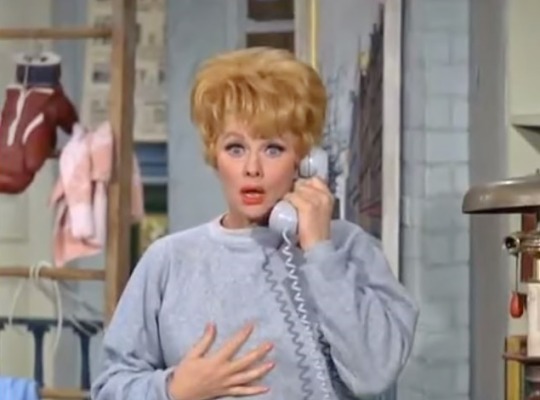
Lucy mistakenly thinks Sandy Koufax is a boxer. Sanford Koufax is a former American Major League Baseball player who pitched 12 seasons for the Brooklyn / Los Angeles Dodgers from 1955 to 1966. Koufax was first mentioned on the series in “Lucy and Viv Play Softball” (S2;E3).

More than once, the episode mentions ‘the Manassa Mauler’ Jack Dempsy. William Harrison Dempsey (1895–1983) was a professional boxer who competed from 1914 to 1927, and reigned as the world heavyweight champion from 1919 to 1926. He was mentioned on “I Love Lucy” several times, mostly by Fred Mertz, who was a boxing fan and former Golden Gloves champion.

When asked if Eddie Rickles is training at Lefty Lattimer’s Gym, Lucy replies that he training at Killer Carmichael’s! She decorates her apartment with boxing posters, sets up a make-shift ring in the kitchen, fills her laundry bag up for sparring practice, replaces her lampshade with a bell, hangs a volleyball as a punching bag, and puts a mattress on the floor for calisthenics. She lies to Mr. Mooney about being sick, saying she has the mumps!
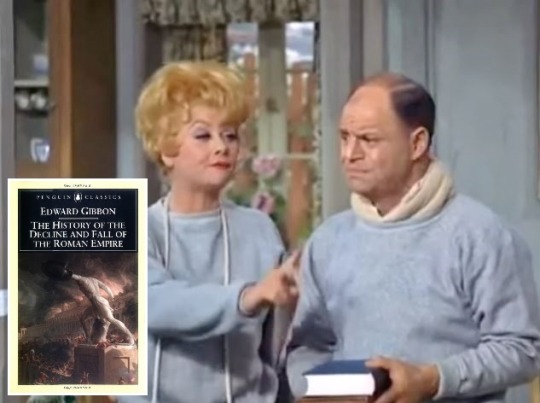
When putting Eddie on the bathroom scales she makes him hold two big books: “The Decline and Fall of the Roman Empire” and “Aunt Fanny's Cookbook” because the scales are off and that is the only way to get an accurate reading. The History of the Decline and Fall of the Roman Empire was written by English historian Edward Gibbon, which traces the trajectory of Western civilization from the height of the Roman Empire to the fall of Byzantium. It was published in six volumes from 1776 to 1889. Hardly reading one associates with Lucy Carmichael. Aunt Fannie's Cookbook, on the other hand...

Ball and Rickles get a round of applause from the studio audience when they jump rope in tandem.

At the end, Lucy knocks Eddie out with one punch and he realizes he has a glass jaw. This is a boxing expression for one who can easily be knocked out by punches to the jaw, a major drawback for a prize fighter.
Callbacks!

Lucy played a fight manager named Kitty Williams in a November 1958 episode of the “Westinghouse Desilu Playhouse” titled “K.O. Kitty” starring Matt Lundigan and Aldo Ray as the prize fighter. The anthology series (hosted by Desi Arnaz) also presented episodes of “The Lucy-Desi Comedy Hour.” Lucille Ball was supposed to play several more non-Lucy Ricardo roles on the series, but this was the only one that ever materialized. It was produced by Quinn Martin, who also came up with the story. It was written by Martin's wife, Madelyn Pugh, and Bob Carroll Jr., the “I Love Lucy” writers who also worked on the first few seasons of “The Lucy Show.”
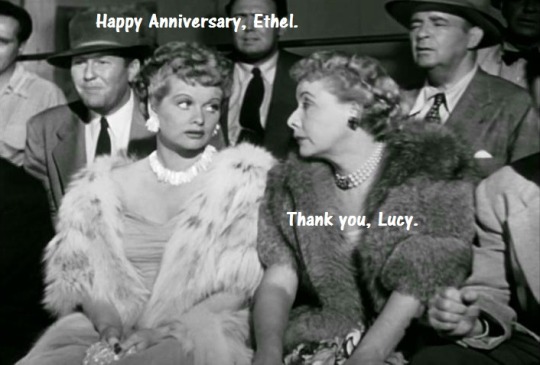
Lucy Ricardo and Ethel Mertz ended up at the fights in the last scene of 1951's “The Girls Want to Go to a Nightclub” (ILL S1;E1), the very first “I Love Lucy” episode ever aired.

Everyone but Lucy and Ethel seem to be watching the fights on television in “Ricky and Fred are TV Fans” (ILL S2;E30).
FAST FORWARD
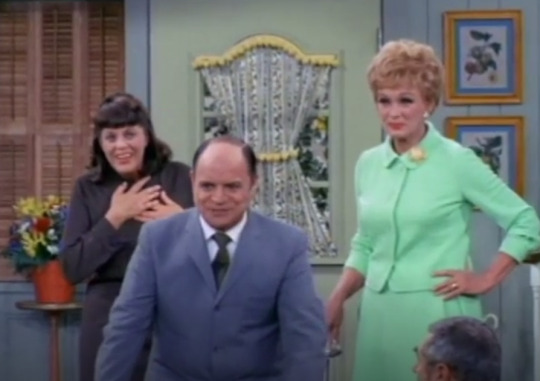
Two years after this “Lucy Show” episode, Don Rickles played himself on the Desi Arnaz sitcom “The Mothers-in-Law” (S2;E24) produced and directed by Elliott Lewis, husband of Mary Jane Croft and was written by original “Lucy” writers Bob Carroll Jr. and Madelyn Davis.

Rickles was mentioned on “Lucy and Sammy Davis Jr.” (HL S3;E3) in 1970, jokingly saying her grouchy neighbor writes fan letters to Don Rickles.

Rickles is mentioned again in 1974′s “Milton Berle Is The Life of the Party” (HL S6;E19) when Berle calls him “the merchant of venom” on a telethon!

In February 1975, Rickles was on the dais to roast Lucille Ball on “The Dean Martin Celebrity Roast.” “Lucy Show” cast mates Vivian Vance, Gale Gordon, Dick Martin, Dan Rowan, Bob Hope, Milton Berle, Gary Morton, and Jack Benny (in his final TV appearance) were also on hand.
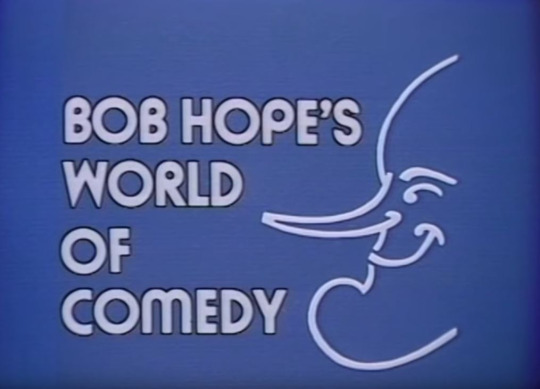
In 1976, both Rickles and Ball were part of “Bob Hope’s World of Comedy” although the two did not share any screen time.
Blooper Alerts!

Where the Floor Ends! When the camera pulls back for a long shot of Lucy's living room, the point where Lucy's wall-to-wall carpeting meets the cement floor of the soundstage can be seen.

Super Hearing? Lucy hears the timer buzzer on the washing machine and says her laundry is done. In “Lucy and Joan” (S4;E4) it was established that Lucy's apartment complex has a laundry room.

Shoeless Joe! After throwing an air punch at Eddie and twirling to the ground, Lucy’s left shoe goes flying off her foot into the living room! A few moments later, Lucy steps out of her other shoe to finish the scene.

“Lucy the Fight Manager” rates 3 Paper Hearts out of 5
#The Lucy Show#Lucy the Fight Manager#Lucille Ball#Don Rickles#Gale Gordon#Cliff Norton#Lewis Charles#Stanley Adams#Bruce Mars#Ronald Axe#Les Roberts#K.O. Kitty#Prize Fighting#Boxing#Sandy Koufax#Jack Dempsey#The Decline and Fall of the Roman Empire
3 notes
·
View notes
Text
In Sherlock’s Room, Part Two
Part One Be Here
Title: In Sherlock’s Room Rating (for this half): PG Total Word Count: 6431 Pairing: bi Watson/ace trans Holmes Universe: Modern AU of the original canon Summary: Holmes solves a case in his jammies. Watson does laundry and makes ravioli.
TW for this half: very vaguely implied past acephobia; another mention of past acephobia (probably past transphobia also) which is immediately followed by petty revenge
Editing was tedious work. My editor, for all his many redeeming qualities, invariably failed to appreciate the flowery endings to my tales and insisted I cut them off far earlier than I should have preferred.
“People read your stories for two reasons,” he once told me after nearly a half-hour of increasingly stormy debate on the subject; “the mystery, and the solution to the mystery. No one cares what happens to you once the crook is sitting in a jail cell. You can spend the night giving each other gob-jobs for all anyone cares. Oh, I’ve said something funny now, have I?”
The bundles of fan mail I received every week inquiring as to whether I was single and whether Holmes was any good at finding hidden sausages made me question his judgment, but I was paid very handsomely for my work. I could afford to assume that he had been made editor for a reason.
My efforts to curtail the offending epilogues on my own proved futile and so I had given up altogether, allowing my fingers to stretch the story for as long as they pleased, knowing that my editor would cut it all anyway while cursing my name. I was well into an appallingly purple passage in which Holmes and I compare the seasonal changes of the leaves to the arc of the average criminal’s career when Holmes burst in, catching the door before it could slam into the wall.
“Ceromancy!” he cried.
“Gesundheit,” I said.
“Kommst du mit, Naseweis.”
One did not need to speak German to understand what he wanted. I followed him back to his room. He had turned on some music since I left, a whiplash-inducing blend of classical pieces and Eurovision finalists. Several new items had taken up residence on his desk. His laptop now sat amongst the clutter rather than on his bed, along with a large, overly fragrant lavender candle, either borrowed or stolen from Mrs Hudson, and a bowl of water with a vaguely egg-shaped bit of hardened wax floating in its centre.
“I take it this is somehow connected with cera… ciril—”
“Ceromancy. It is the art of divining the future via wax images in water. One of the methods involves adding certain ingredients to the water, including seeds of the cuminum cyminum, which Mrs Mulvehill reports smelling in her wife’s vehicle on more than one occasion, and sprigs of ruta graveolens, a toxic herb that can cause blisters.”
I recalled the neatly torn note in the package that had started Holmes’ day, in which Mrs Mulvehill remarked upon the blisters on her wife’s hand.
“Further,” Holmes continued, “this particular set of instructions involves tying two candles together with a red ribbon.”
He spun the laptop so I could see the screen, though I hardly needed to look to know what would be there: the photograph of the red ribbon tied to the rearview mirror.
“That looks about long enough to bind a pair of candles, does it not?” said he.
I thought it strange that a woman should drive five hours one way every weekend simply to have her fortune told, and said so to Holmes.
“I have not yet finished examining all of the evidence. There may very well be another explanation for these clues that will become apparent once I reach the end of my investigation.”
“So there is still a chance that Polly Mulvehill is seeing another woman?”
“Unfortunately for our client, yes.”
He lifted a hand to swipe to the next photograph, then gave it a second thought and turned to me instead.
“Why do people do it?” he asked.
“Do what?”
“Cheat. Polly Mulvehill has a perfectly devoted and intelligent wife, but that wasn’t enough for her. She still felt the need to fill her time and, presumably, various other things with someone else, all in pursuit of a few sweaty, sticky moments on a flat surface. What can possibly be so thrilling about sex that it drives people to betray those closest to them? It can’t be any better than a concert at the Barbican, and I wouldn’t cheat on you for a box seat.”
That hadn’t ever been a concern of mine, but it was nice to know.
“Sex is pleasurable for a lot of people,” I said, “and for some, it confers a certain status that concert tickets don’t. It makes them feel powerful, attractive, special, even loved—”
“That hardly justifies cheating.”
“Of course it doesn’t. I suppose some people never learned the same sort of self-control that you have with regard to box seats.”
He laughed at the jab and began setting up his chemical apparatus as the delicate dénouement of Gluck’s Melodie ceded to the gravelly bombast of Lordi’s Hard Rock Hallelujah.
“What are you going to do now?” I asked.
“I must test the dirt samples sent to me by Mrs Mulvehill to determine if there is anything distinctive about them. The definitive answer to the question of how Polly Mulvehill has been spending her weekends may well be lurking in one of these test tubes.”
He muttered a few more disparaging comments about unfaithful spouses before returning to work. I sat on the edge of Holmes’ bed and ran a finger along a seam in his blanket. It had some peculiar stains that I would have to remember to ask about, to make sure he wasn’t slowly poisoning himself in his sleep. Not for the first time, I was grateful that we had elected to retain separate bedrooms even after starting our relationship.
At that time it had been almost a decade since I last slept with someone. Her name was Allie, or something like it. She was tall and dark and sarcastic and just barely passable in the bedroom. I suppose it was the lingering memory of her mediocrity that helped reinforce the idea of there being more important elements than sex in a romantic relationship when Holmes wrote me the first of what would become an entire drawerful of love letters. He made it clear from the very start that he could offer me every sort of intimacy except that one, but that does not make our relationship in any way less. Maybe it’s the fact that I will never have the chance to confront this issue in my published works that compels me to be perfectly clear about it here: we are lovers, in every sense of the word except that one upon which our society places the most importance.
Well, I suppose I shouldn’t judge others for their ignorance. I held a similar view in a past life. “Experience of women on three continents” was, despite what my editor prefers to believe, not an exaggeration. Nor is it an exaggeration to say I have never once regretted abandoning my old ways. Who wouldn’t give up sex for love?
Perhaps not Polly Mulvehill. Or perhaps she really did learn her lesson and would agree with me after all. It seems to me such an obvious decision, but on those infrequent occasions when I have attempted to explain our relationship to an outsider, I am almost inevitably met with disbelief at best. Mrs Hudson took it in her stride, bless her, but Lestrade got very confused when I responded to his barely veiled innuendos with the truth. I am slightly ashamed and very satisfied to say that I went for the jugular almost immediately.
“If your wife got sick and wasn’t able to have sex with you anymore, or if her hormones change as she gets older and her libido drops, which does happen by the way, would you walk out on her just because she wasn’t giving you any?”
“Of course not!” To Lestrade’s credit, he looked scandalised at the very suggestion. “She’s my wife, the mother of my children—”
“It’s the same with us. Well, not exactly the same. Obviously, there are some differences in our lines of reasoning, but my point is that you love your partner more than you love sex and so do I. That is, I love my partner more than I love sex, not your partner. You know what I meant,” I said, irritated, when he started laughing.
“You’re much more eloquent as a writer than as an orator,” he replied, but he bought me a pint as an apology and we never spoke on the matter again.
I suppose I could have laughed along with his jokes instead of lecturing him on asexuality, but I should have felt guilty allowing him to continue operating under the assumption that Holmes and I were doing it. The mere idea of engaging in such activities makes Holmes so terribly uncomfortable. Having to endure ribald ragging, no matter how good-natured, from the one police inspector he respects could only end unpleasantly for both parties.
Feeling suddenly maudlin, I moved my bad leg so it rested fully on the stained blanket, leaned back against the headboard, and watched as Holmes went about his work. His hands, despite appearing ill-fittingly large on his slender wrists, always managed to look graceful when engaged in one of his chemical experiments. But I suppose everyone looks more themselves when they are doing what they are best at.
I believe I drifted off a bit after that, lulled into a contented daze by the rhythm of clinking glass and the scratch of pencil on notebook paper. I began to come out of my trance when he came out of his. He tried and failed to control a smile. A few scribbles later and he gave up all pretense of dignified detachment, jumping in place and clapping, sending the pencil clattering into the dustbin beside his desk. That was alright. He preferred to keep his writing implements in there anyway.
With but a short moment of warning he swept me into his arms, then released me and tugged me towards his desk before I had the chance to hug him back.
“This is far better than I could have hoped for! What a splendid case this has turned out to be!”
“Such excitement for a bit of dirt,” I remarked.
“No mere ‘bit of dirt’ is this. Have a look at the results of the soil analysis I ran.”
I did as he asked. Even with my limited understanding of soil composition, I knew at once what had brought the light to his grey eyes.
“Iridium?”
“Yes. It is exceedingly rare on Earth but much more common in meteorites.”
“I know what it is. I just didn’t think you would, given your extreme disinterest in astronomy.”
“I looked it up,” Holmes said, witheringly. Then, perking up, he added, “I suspect the sample in Polly Mulvehill’s boot came from such a meteorite, or perhaps from an object that was found within the iridium anomaly.”
“You did say she works at a museum.”
“She volunteers as a tour guide. I rather doubt she has the authority to take archaeological treasures home with her.”
“So you’re saying—”
“Museums are a study in contrasts, my dear Watson. In their exhibition rooms, they are well-organized, often beautifully laid out bastions of knowledge dedicated to preserving the past into the future. However, safely shielded from the public eye is invariably an overcrowded and poorly catalogued backroom littered with valuables that could be missing for months or years before anyone noticed. Why, I stole this very spoon from the British Museum over a decade ago and still they’re none the wiser!”
“Holmes!”
“Oh, come now, Boswell. This is a soup spoon from my mother’s flatware collection. Do you really think so little of me?”
“On the contrary, I think highly enough of you that I expect you could abscond with the British Museum’s entire collection of Egyptian antiquities and return them to Egypt before the guard could leave his chair. Why do you have your mother’s soup spoon?”
Holmes abruptly stopped preening at my inquiry.
“After my last visit to Sussex, you asked why I was in such a strop and I wouldn’t tell you.”
“Yes?”
“She kept asking when you and I would give her grandchildren. I should have run out at once and arranged for a hysterectomy if Mycroft hadn’t been there to stop me. Instead I took her soup spoon. Are you very angry with me?”
“Not with you, no.” But the next time I was misfortunate enough to encounter Mrs Holmes, I thought I might distract her long enough for Holmes to make off with the rest of her flatware, and possibly a vase or two. I did not tell him the specifics of my thoughts, instead running a careful hand through the tangles in his hair. He was much more appreciative of such gestures when not occupied by a case. Had I attempted to demonstrate any form of affection prior to the discovery of the iridium, he should have pulled back and shook his head, putting a stop to my ministrations. Now, he not only permitted the display, he encouraged it, throwing back his head with a contented sigh. He grasped my free hand with both of his, enjoying the light scratch of my callouses across his own, eyes closed so he could focus on the sensation.
At length he straightened in his chair and looked around, as if in search of something.
“I believe we have gotten rather off the subject,” he said. He crowed with victory when he made visual confirmation of his laptop teetering precariously on the edge of his desk, where it had been shoved to make room for the chemistry equipment. “I must get in touch with Mrs Mulvehill—Mrs Evelyn Mulvehill, that is—and alert her to the happy news.”
“I would hardly call the fact that her wife is stealing from her place of employment happy news, Holmes.”
“Perhaps not to you or I, but to a woman bracing herself for the news that her beloved has yet again been unfaithful, it may well be the highlight of her day.”
I never saw Evelyn Mulvehill’s response to the longwinded email Holmes sent containing his deductions, but Holmes informed me it was cordial and grateful and would I please stop scribbling in my notebook? He had just learned the most wonderful new waltz that I was sure to love if only I’d pay it the attention it (and he) deserved.
We did not hear from the Mulvehills for nearly a fortnight. At that time, as a harsh rain assaulted the streets and the rooftops of London, Holmes thrust an open envelope, sent from Kendal, Cumbria, under my nose. Along with her cheque came a letter from our former client, thanking Holmes for his help and informing us of the full meaning behind the clues he had deciphered for her. Evelyn confronted her wife about the matter the moment she returned from work on the day of Holmes’ revelation. Polly, to her credit, admitted to the scheme at once, but the story which followed her confession was one that neither of us could have expected.
Polly Mulvehill loved her museum and the history it saved and displayed, but the longer she worked there, the more she realised how dependent it was upon artifacts illegally obtained when Britain was at her most imperialistic. What right did any museum, even the one she held so near and dear, have to keep such items? She made then a vow to smuggle what she could out of the museum and back to the lands from which they had been taken.
She sought out a fence, a man based in Aberdeen who was very superstitious and insisted upon consulting a friend who specialised in divination, including ceromancy, before each and every step of their exchange. At least twice, to Polly’s intense displeasure, the fence interpreted the candle drippings negatively and refused to accept the goods, forcing Polly to return with the stolen artifacts to Kendal until the following week. Still, the trouble was worth it, Polly Mulvehill insisted, for the fence was just as devoted to repatriation as she and would do most anything, so long as the candles gave their blessing, to bring the haughty English down a peg. Upon receipt of the stolen items, the fence made his escape on a flight from Aberdeen International Airport, which Polly only made the mistake of booking a hotel next to once, compared with the eleven times she had travelled to Aberdeen on her self-imposed mission. One was also the number of times she made the mistake of handling the herbs which the fortune teller used to predict their chances of success.
Evelyn was so awestruck by her wife’s courage and integrity that she quit her accounting job and started an organisation dedicated to negotiating the legal return of all stolen artifacts to their countries of origin. It is an organisation the Mulvehills run to this very day. The missive ended with a plea veiled as a compliment, stating that Evelyn Mulvehill knew Holmes to be a gentleman of the utmost discretion, and that she trusted him to breathe not a word of her wife’s rashness to the authorities. The final item enclosed in the envelope was a familiar, stout red ribbon. Holmes smiled when I held up the ribbon and requested I put the note into the fire.
“Another mystery over and done with,” said he, snapping the blinds shut against the sight of the driving storm. “Will you be writing up this case for your eager public?”
“I doubt it. I spent more time folding your laundry than doing anything related to the case. Perhaps I could end it with a big car chase through Aberdeen between us and the superstitious fence. Maybe throw in the Mulvehills for good measure.”
Holmes chuckled around the empty pipe in his teeth.
“It is no more or less ludicrous than anything else you have written,” he said.
I chose to interpret this remark in a positive light.
Were this a polished and published work rather than a hastily scribbled collection of remembrances in a shabby moleskin notebook, my editor should have ended the account with my destroying the evidence of Polly Mulvehill’s crimes and her wife’s complicity. It is just as well. Holmes is, despite the great fame I have inadvertently thrust upon him, an intensely private man. I doubt he would appreciate the whole of the English-speaking world reading about how we sat together on the sofa, shoulder to shoulder and hip to hip, he kneading the pain from my bad leg with a practiced hand, I reading selections from the story I had been editing and taking note of the parts he disapproved of. He certainly wouldn’t want anyone else knowing about how our light bickering over whether or not I was allowed to describe him as gentle ended in several minutes of kissing that served my argument rather better than his. And, most of all, he would recoil at the slightest possibility of strangers spying after the fact as he pulled out his laptop and helped me work out plans for a weeklong holiday in Cumbria.
5 notes
·
View notes
Text
Debt Settlement Program
New Post has been published on http://aopsy.com/index.php/2017/04/19/debt-settlement-program/
Debt Settlement Program
Debt Settlement Program Can Help Eliminate Partial Debt
Persons drowning in debt should never face their financial dilemma alone and should never ignore their creditors. Owing a debt is not one of those things that goes away if you do not acknowledge it, rather it usually simply grows into a bigger problem. When you first realize that making payments is going to be a hardship, you should contact the lender about a debt settlement program, in which they may be inclined to accept a partial payment of the amount owed and discharge the rest of the obligation.
The Internal Revenue Service is the most famous for offering a debt settlement program for individuals and some businesses that get behind in the income tax obligations. However, whether dealing with the government or a private lender, asking about a debt settlement program before your account become seriously past due has a better chance of being accepted than waiting until the lender begins collection proceedings.
Unsecured credit cards are another possibility and while a few of the companies are stringent about accepting lower payments, in order to avoid the expense of a long, drawn out collection process, they may be amenable to a debt settlement program accepting a partial payment on the total balance owed. Of course, if they accept it, your card will be cancelled and one strike will be placed on your credit score.
Too Much Debt Can Require Several Steps
For a person who is late with payments on several credit cards, it may not be possible to find a way to negotiate into a debt settlement program with all of them. They may have to go through a credit counseling service and have them all placed in to the debt settlement program at one time. Working with the counselors it may be possible ti devote a large lump sum payment to get one creditor off the list and the monthly payments made will than be increased among all the remaining creditors.
Regardless of how deep a person is in debt, there are two things they need to remember. First, do not ignore their creditors. Communicate as soon as you know the payments will be hard to make. Additionally, do not try it on your own. You obviously got into the current condition due to either unemployment, an illness or just bad money management. Find a debt settlement program operate by professionals and get the needed help to make sure you can pay the bills and get back on your financial feet.
#post- .CPlase_panel display:none;
0 notes
Text
‘These COVID-19 wins’
When someone with COVID-19 graduates from the intensive care unit, a celebration erupts.
Nurses, doctors, respiratory therapists and nurse techs cheer, clap and play their victory song as the patient is wheeled down the hall.
The team that cares for the most critically ill patients in the ICU at Spectrum Health Butterworth Hospital draws strength from those successes as they continue the challenging work of caring for those ill with the new coronavirus.
“Even though we are cheering on the patients, that excitement and joy is also for us,” said Patti DeLine, the nurse manager of the ICU designated to care for COVID-19 patients. “We are celebrating what has come to fruition and all the hard work our team has put into getting that patient healthy again.”
It’s a tough job—caring for patients as they fight life-and-death battles against a new disease that has swept across the globe in just months after it was identified. Not everyone survives. The medical team mourns each death.
And that’s one more reason why each victory, each recovery and graduation from the ICU, feels so rewarding.
Since the first COVID-19 patient arrived in the Butterworth Hospital ICU, the medical team has seen 78 patients graduate from the unit.
They have removed 34 patients from ventilators—and watched as the patients once again breathed on their own.
“When we have these COVID-19 wins, you can see them beaming with pride,” DeLine said. “They were able to make that happen.”
Helping patients heal from this new coronavirus taps the team’s mental, physical and emotional resources. They research new developments while drawing on skills and knowledge gained treating other illnesses.
By the time the first patients with COVID-19 arrived at Butterworth Hospital, the medical team had followed developments in other areas—Italy, New York and Detroit—where surges in patients stretched the capacities of medical systems.
“Obviously, you learn from those who are ahead of us on the road in terms of what works and what doesn’t work,” said pulmonologist Stephen Fitch, MD.
“The longer you go into this, the more you learn, the more information you have—and that informs your care and what you are doing.”
Ventilator support
Although the novel coronavirus was just identified in late 2019, physicians can apply what they know from treating other patients with other illnesses, including influenza, the H1N1 flu, and the viruses that cause SARS and MERS.
Most of the patients have severe inflammation in the lungs, either from pneumonia or the inflammatory response caused by acute respiratory distress syndrome. The lungs, unable to do their job of exchanging oxygen with carbon dioxide, send less oxygen into the bloodstream—and to the organs that require it.
Doctors deliver supplemental oxygen through a nasal canula—or a high-flow nasal canula, if needed.
“If that’s insufficient, you have to use a ventilator,” Dr. Fitch said.
Patients typically are sedated as they are intubated, and the ventilator begins to deliver oxygen into the lungs.
This helps patients get needed oxygen, while also relieving them of the work involved in breathing. When oxygen is in short supply, breathing taxes the respiratory muscles—and that in turn increases the need for oxygen.
Not all ICU patients with COVID-19 require ventilator support. Those who do spend an average of 10½ days on the ventilator.
During that time, the medical team carefully monitors the patient’s oxygen level and the condition of the lungs, adjusting ventilator pressures to optimize lung function.
“As those mechanics get better and the blood parameters get better, we are continually working to wean that level of support and the level of sedation,” Dr. Fitch said.
Also as part of standard ICU care, the team provides nutritional support, occupational and physical therapy.
“These are supportive therapies, not cures,” Dr. Fitch said. “They don’t make the virus go away. But they are all treatments that we know from scientific study improve patient’s survival and help them recover and get back to baseline.”
The team also puts patients in a prone position—turning them on their stomachs—often for 12-16 hours a day. This relieves pressure on the lungs and opens airways.
Other treatments include plasma therapy using plasma donated by those who have antibodies to the COVID-19 virus. Patients may also receive anti-inflammatory medications and antiviral drugs, such as Remdesivir, which was developed to treat the Ebola virus.
Th medical team continues to study reports from the Centers for Disease Control and Prevention and other health systems, as well as evaluating its own practices, as it works to provide the best treatments for the patients.
“We are certainly encouraged by the positive outcomes we have seen in our health system,” Dr. Fitch said. “We have to figure out what things we are doing that we can attribute that to.”
Tilting beds
Dr. Fitch credited nurse Michelle Rowland with leading the way on one change in practice.
Rowland took care of a man whom she believed would benefit from proning—being turned on his stomach.
She requested an order from a physician and a team to help turn over the patient—it takes four or five nurses and nurses techs, plus a respiratory therapist to move a critically ill patient from his back to his stomach.
While waiting for everything to fall into place, she realized she could take an interim step. The ICU beds include a “lateral rotation” feature, which slowly rocks the bed from side to side.
Although designed to prevent bed sores, Rowland thought it might help patients with fluid in their lungs.
“When those lungs get that sick, they get like soggy sponges,” she said. “We know that moving them frequently helps.”
She turned on the lateral rotation. Like a slow-moving cradle, the bed rocked slowly back and forth, changing positions every 10 minutes. It tilted one side up 20 degrees, then returned to a flat position, then tilted the other side up 20 degrees.
She soon saw results—a steady improvement in the man’s oxygen levels.
DeLine wasn’t surprised by Rowland’s ingenuity when she learned what she had done.
“She is very creative. She is always thinking ahead,” DeLine said. “She is a fantastic nurse.”
She and Rowland discussed the approach with a clinical research nurse and Dr. Fitch.
“Now we turn it on with nearly every single COVID-19 patient,” DeLine said.
It’s hard to tell how much it affects a patient’s recovery—amid the many other therapies provided. But DeLine believes it may help by shifting fluid off areas of the lungs, allowing them to work better.
That kind of out-of-the-box thinking is common among those drawn to work in the medical ICU.
“Dr. Fitch is leading this team in a way that is curious and collaborative,” DeLine said. “We all work together. That makes a huge difference when you have people who are willing to step up and do what is right for each patient.”
Giving extra love
Keenly aware that patients are separated from their loved ones, the nurses do all they can to bring a sense of human connection.
“We are acutely aware that they don’t have the love of their family there, so we are giving them extra love to make up for it,” DeLine said. “Even though we are in gowns and gloves, that doesn’t change the fact that we love what we do.”
The nurses arrange video calls for patients and family members. And they call loved ones to let them know about big and small milestones.
“We will call sometimes just to say he opened his eyes. He squeezed my hand today,’” DeLine said. “If my family member were here, I would want to know there is someone in there holding their hand, wiping their tears and smiling at them when they wake up.”
Just as the medical team celebrates patient’s victories, they take it to heart when a patient dies.
In addition to the 78 COVID-19 patients who have recovered enough to leave the Butterworth Hospital ICU, 33 patients in the unit have died. The nurses and therapists who care for them grieve for the patients and their loved ones.
“It is heartbreaking,” DeLine said. “The nurses look at them like that’s their grandpa, that’s their dad. You can’t help but see the people you love in the people you are caring for.
“There are a lot of things that are difficult for the nursing staff. We talk a lot about coping skills, about recognizing burnout and stress.”
The team also has access to services Spectrum Health offers employees to help cope with stress, including counseling, spiritual support, yoga classes and a meditation app.
That dedication, combined with skills and experience in ICU care, are key elements in patients’ recovery, Dr. Fitch said.
“It’s just astonishing to me—the persistent, steady effective work that people do every day to take care of these patients,” he said. “That is one of the central pieces: good solid training on how to take care of sick patients and attention to details.
“Doing that over and over again, day after day, is what wins the day.”
‘These COVID-19 wins’ published first on https://smartdrinkingweb.tumblr.com/
0 notes
Text
What Muslim ban? 2020 Democrats go easy on Trump
New Post has been published on https://thebiafrastar.com/what-muslim-ban-2020-democrats-go-easy-on-trump/
What Muslim ban? 2020 Democrats go easy on Trump
American Muslims perform Eid al-Fitr prayers that mark the end of the holy fasting month of Ramadan on the Niles West High School football field in Skokie, Ill., on June 5, 2019. | Amr Alfiky/AP Photo
2020 elections
Muslim-American activists say their issues are getting short shrift in the Democratic primary.
Donald Trump’s travel ban triggered a nationwide backlash on the left — but in the eyes of many Muslims, you wouldn’t know it listening to the Democratic presidential hopefuls.
Now, Muslim operatives and activists are expressing alarm that their community has been all but neglected by the 2020 contenders as they focus on more prominent voting blocs. They say Trump has repeatedly antagonized Muslim Americans — not only with the travel ban barring most people from several majority-Muslim countries from entering the United States, but with his singling out of Muslim members of Congress — and based on the campaign, he appears to be getting away with it.
Story Continued Below
The travel ban was discussed for less than two minutes during the first two Democratic primary debates in June and July, they note. They say it’s rarely mentioned in candidates’ stump speeches, either.
“This is an issue that they aren’t taking as seriously as they should be,” said Mohamed Gula, executive director of the Muslim advocacy group Emgage and a former staffer on Hillary Clinton’s 2016 presidential campaign. “Us being about 1 percent of the American population, to be ignored in that way, is definitely kind of putting a chip on our shoulder.”
Rabyaah Althaibani, a co-founder of the political consulting group Arab Women’s Voice, added: “It’s disappointing. I’m Yemeni and I don’t know a single Yemeni family that isn’t directly impacted by the Muslim ban.”
Activists also argue that the Democratic presidential contenders have not paid enough attention to Islamophobia and the recent spike in anti-Muslim hate crimes. Nor are they mobilizing Muslim voters quickly enough ahead of the presidential election, they say.
Some Muslim activists think the candidates might not be speaking more about the ban or other issues out of fear of alienating voters with Islamophobic beliefs or being linked to progressive Muslim lawmakers such as Reps. Ilhan Omar and Rashida Tlaib. Others believe it’s an oversight, or a result of advocates not shining as much of a light on the ban as they did when it was announced.
“It’s no secret that when you look at the polling, there are significant numbers of Democratic voters and Republican voters who have fairly strong Islamophobic tendencies,” said Waleed Shahid, communications director for the left-wing Justice Democrats and a former aide to Bernie Sanders. “I think the way to deal with that is to have strong leadership on the issue.”
Though Muslims make up a small percentage of the American population, a Democratic candidate could still benefit at the ballot box if he or she wins the trust of Muslim voters. In 2016, Sanders scored an upset victory over Clinton in Michigan partly by performing strongly in areas with large numbers of Arab Americans.
There’s also evidence that Muslim voters are becoming increasingly organized and could play a bigger role in the presidential race than they have in the past. From 2014 to 2018, voter turnout among Muslims increased by 25 percentage points in the key states of Ohio, Florida, Michigan and Virginia, according to an analysis by Emgage. A record number of Muslim Americans also ran for office, and won, in last year’s midterm elections.
“I’ve been surprised at how little discussion there has been around Islamophobia and the Muslin ban, especially in the context of Trump honing in on attacks on Muslim congresswomen,” Shahid said. “A lot of these primaries are going to be won and lost in the margins.”
Shahid and several Muslims activists without ties to the Vermont senator said Sanders has done more than any other 2020 candidate to reach out to Muslim voters. They cited the fact that he helped pass a bill to end the United States’ involvement in the civil war in Yemen, has long been a critic of the Israeli government’s treatment of Palestinians, and quickly came to Omar’s defense when other Democrats accused her of anti-Semitism. Sanders’ campaign manager, Faiz Shakir, is also Muslim.
Muslim operatives credited Elizabeth Warren for also swiftly defending Omar and Beto O’Rourke and Jay Inslee for talking about the travel ban during the debates.
In a direct reference to Omar, O’Rourke said: “It doesn’t just offend our sensibilities to hear him say ‘send her back’ about a member of Congress because she’s a woman of color, because she’s a Muslim American. It doesn’t just offend our sensibilities when he calls Mexican immigrants rapists and criminals or seeks to ban all Muslims from the shores of a country that’s comprised of people from the world over, from every tradition of faith. It is also changing this country.”
In an interview with POLITICO, New York Mayor Bill de Blasio said he has tried to change non-Muslims’ views of Muslims by, for instance, adding Muslim holidays to the school calendar and highlighting Muslims’ role in his city’s government.
“I started talking about the fact that there are 1,000 NYPD cops who are Muslim,” he said. “It’s a small thing, but people had no idea.”
Some Muslim Democrats were critical not of the 2020 candidates, but of the media, for not posing questions about the travel ban and Islamophobia at debates and other events.
“Why aren’t they asking about the Muslim ban? They should,” said Minnesota Attorney General Keith Ellison, who has endorsed Sanders.
Ellison added that Muslim activists who are disappointed with Democratic presidential candidates should not lose sight of the differences between the two parties: “By all means, demand more of the Democratic candidates. Insist that they address Muslim issues. But please don’t forget that … the only time Muslims come up among Republicans is when they talk about banning us.”
Linda Sarsour, a high-profile Muslim activist and surrogate for Sanders, said the 2020 candidates are doing far more to reach Muslims than presidential contenders of the past, though “there’s obviously much more work to do.” She said Muslim civic groups have also been stepping up their efforts to register voters ahead of the election.
The Democratic presidential candidates will have a chance to speak directly to Muslim activists at the Islamic Society of North America’s annual convention in Houston later this month. Gula said 20,000 people are expected to attend.
So far, Sanders and Julián Castro have confirmed they are attending.
“Like many Americans, Muslim Americans are wondering why their wages are flat. Muslim Americans are wondering why the cost of prescription drugs keeps going up,” Omar told POLITICO. “But Muslim Americans are also subject to explicitly racist policies from the current president of the United States — including a Muslim ban. We must be the party that affirmatively confronts the president’s open Islamophobia and bigotry. But we also need to connect Donald Trump’s racism and bigotry to his larger corruption. The president is openly demonizing Muslims and immigrants to distract from his own failure to govern.”
Read More
0 notes
Text
Why Scandinavian Banks’ Clean Reputations Are Threatened by Dirty Money
What would you do if you were a bank executive and learned that some customers were known criminals, the money came from banks notorious for money laundering, large numbers of customers had the same address or phone number, an indication they could be fronts, and some clients would transfer money and then immediately transfer it again, often to an offshore account: (1) nothing and continue to profit from these transactions, (2) inform regulators, and/or (3) refuse to do business with these customers? Why? What are the ethics underlying your decision?
Scandinavia has long had a reputation as one of the most progressive regions in the world, known for generous parental leaves, bicycle superhighways and Abba.
So it has been a shock to see Scandinavian banks mired in a growing money laundering scandal, accused of helping Russian oligarchs, corrupt politicians and organized crime lords send hundreds of billions of ill-gotten dollars to offshore tax havens.
Danske Bank, the largest bank in Denmark, was caught first for suspicious activities at its subsidiary in Estonia and, in the past couple weeks, the scandal has spread to Swedbank and its subsidiaries in the Baltics. Swedbank’s chairman, Lars Idermark, resigned Friday, saying that the media storm surrounding the money laundering allegations was a distraction from his day job as chief executive of a forest products company.
Mr. Idermark’s exit came less than a week after the bank fired its chief executive, Birgitte Bonnesen, who had previously supervised Swedbank’s operations in the Baltic countries.
The revelations are stunning for what had been respected institutions. How did the Swedes and Danes get sucked into underworld relationships? Why are American investigators — federal and New York State — poring over their accounts? And how does this all harken back to the fall of Communism two decades ago?
Here are the answers to those and other questions.
For a Danish bank, trouble in Estonia
Danske Bank has admitted that its Estonian subsidiary helped thousands of customers, most of whom were not residents of Estonia, to launder tens of billions of euros from 2007 to 2015.
Over the years, Danske Bank managers ignored or played down warnings about suspicious transactions by Estonian regulators, the Russian central bank, partner banks and its own internal auditors. The Estonian operation processed transactions worth 200 billion euros, or $225 billion, involving foreigners and generated profits far out of proportion to its size. The Danish bank regulator took little action and its money laundering unit was woefully understaffed.
Danske Bank did not acknowledge the problems until 2017, after Danish media reported on them. The full scale of the wrongdoing did not become publicly known until September 2018, when Danske Bank released an investigation conducted by an outside law firm. The bank admitted that it had “clearly failed to live up to its responsibility” and the chief executive, Thomas Borgen, resigned under pressure.
How did Sweden come under scrutiny?
The allegations against Swedbank, which also involve its operations in the Baltics, have come to light in recent months after reports by Swedish public television. But the New York Department of Financial Services had been looking into possible money laundering at Swedbank for at least a year.
In February, the department sent Swedbank’s New York subsidiary a letter with extensive questions about transactions involving Russian businesspeople and officials, offshore companies and banks in Ukraine, Cyprus and other countries that have been considered money laundering hubs.
The action by the New York regulator is part of a larger inquiry stemming from the activities of Mossack Fonseca, the law firm whose efforts to help the superrich avoid taxes were exposed by the so-called Panama Papers, a trove of bank documents leaked to investigative journalists.
The report by Swedish television suggested that Swedbank had also been a conduit for payments by the deposed Ukrainian President Viktor Yanukovych to his erstwhile adviser, Paul Manafort, the former Trump campaign chairman who has been convicted of tax evasion and bank fraud.
A spokesman for the Department of Financial Services would not comment on the connection to Mr. Manafort, but the regulator’s letter to Swedbank in February requested information about transactions involving Mr. Yanukovych.
Swedish prosecutors say that the country’s statute of limitations prevented them from pursuing money laundering charges against Swedbank since the suspected activity ended in 2014. But they are conducting a related investigation.
Unnamed Swedbank employees are suspected of tipping off a select group of large investors that a scandal was about to break, a possible violation of insider trading laws. Last week, officials from the Swedish Economic Crime Authority raided Swedbank headquarters in Stockholm and seized documents as part of that investigation.
Sweden’s financial industry regulator, known as Finansinspektionen, is also investigating, as are the Estonian authorities.
Why are American investigators involved?
The Justice Department and other American officials have long done the heavy lifting when it comes to money laundering enforcement in Europe. That is because local authorities have often not been up to the task.
Almost all big international banks, including Danske Bank and Swedbank, have subsidiaries in the United States that they use to process transactions in dollars. That gives federal and state investigators a legal foundation to travel far outside their borders. The Americans have done so aggressively.
European lenders like ING Group in the Netherlands, Deutsche Bank in Germany or BNP Paribas in France have paid $16 billion in fines for money laundering infractions or sanction violations since 2012, according to a study published this past week by Moody’s Investors Service. More than three-quarters of that sum was imposed by the Justice Department or other American authorities, Moody’s said.
The dominance of American investigators reflects the conflicted state of European enforcement. Responsibility rests primarily with national regulators, which often lack the resources and training to tackle money launderers or are unwilling to police big, politically connected lenders. Or they are prone to corruption themselves.
“The banks and supervisory authorities have been very complacent,” said Nicolas Véron, a senior fellow at Bruegel, a think tank in Brussels, who follows banking issues. “The system has failed.”
As the Soviet bloc fell, so did banking barriers
The collapse of the Soviet bloc almost three decades ago opened up Eastern Europe to Western European banks.
It was virgin territory — with millions of customers who previously had little or no access to credit — and the Western European banks carved up business along geographical and historical lines. The Scandinavian banks took the Baltics, while Austrian banks worked in Hungary, Slovakia, Romania and other places that had once been ruled by the Hapsburg dynasty.
At the same time, Russia evolved into a crony capitalist economy, breeding oligarchs and officials who wanted to move money to havens outside the country. A logical place for them to go was Estonia, which has a large Russian-speaking population. Tallinn, the capital, is less than six hours by car from St. Petersburg.
Danske Bank became a major force in Estonia in 2007 by acquiring the Finnish bank Sampo, which had a large foothold in the country. Sampo’s Estonian subsidiary was already a destination for foreign money. More than one quarter of its deposits in Estonia belonged to nonresidents, and the proportion continued to grow after Danske took over.
But Danske’s oversight of the Estonian subsidiary was weak. Many of the transactions by foreign clients were obviously fishy, the bank’s own investigation found.
Some customers were known criminals, or the money came from banks notorious for money laundering. Large numbers of customers had the same address or phone number, an indication they could be fronts. Some clients would transfer money to Estonia, then immediately transfer it again, often to an offshore account. That was a sign that lenders were being used to obscure the money’s origin.
Further complicating matters, Danske allowed its Estonian operation to maintain a separate information technology system. Many documents were written in Estonian or Russian, making it difficult for compliance officers in Denmark to know what was going on.
Now, operations that once seemed like lucrative outposts on the frontiers of capitalism have turned into liabilities for the Scandinavian banks.
Danske pulled out of the Baltics earlier this year. Swedbank has said it remains committed to Estonia, Latvia and Lithuania.
0 notes
Text
Patient Access – Pros and Cons to Improve your Healthcare Practice
In the United States, we have certain expectations as consumers. We expect to shop around, read reviews, and select the best-performing and most cost-effective product. In essentially everything we want to buy, from a new television set to a vacation package, we can do this. There’s plenty of information available to us so that we can make an informed decision. Yet, when it comes to the most important service of all – our health – we can’t shop around, so to speak. Consumers of healthcare – patients – are limited to picking a physician within their insurance network. Or be limited to only doctors they can afford. When they do go, they blindly accept the treatment plan outlined to them by a physician, without knowing what it might cost in the end. Yet, today more and more technologies are emerging that give patients the tools that they need to make more informed decisions about their healthcare. These tools range from public physician reviews, online scheduling, text reminders about appointments or medication refills, and even digital access to review their own medical records. Are you making these tools available to your patients? Here are the pros and cons of improving patient access in your practice and why it is so important to do so.
Why Improving Patient Access is Important
There are many meanings to patient access, from their proximity to the hospital to affordability. In this article, patient access means all of the ways in which patients can access information or data about their healthcare. Therefore, an increase in patient access will help patients to feel more in control of their healthcare experience and the outcome of it. Today patients are engaging with their healthcare more so than ever before. In a study conducted by tech company IBM found that thanks to modern technology, each person will generate enough health data in their lifetime to fill 300 million books. During the past two years, people have collected more data about their health than they have in all of human history. IBM predicts, that by 2020, medical data could double every 73 days. Now, for the first time, humans can process all of this data and actually use it to better themselves.
But why does this matter? First of all, improving patient access to healthcare data gives patients more control and gets them more invested in not only their treatment plans but also their preventive care. In a perfectly stated quote published on the U.S. Department of Health & Human Services website, Dr. Mary P. Griskewicz said, “There’s a gap in educating patients that they have a right to their health information and need to become active participants in their health care.”
When patients become active participants in their healthcare, everyone benefits. The patients feel better, and physicians have an easier time getting their patients to a point where they are experiencing true, whole body wellness. There are so many tools out there that can help you improve patient access at your practice, from those that measure and monitor the workflow in your practice to those that help your office assistant with scheduling and better identifying patient symptoms prior to their appointment. Yet, like everything else in life, more knowledge can be a good or a bad thing. There are definitely pros and cons to consider when it comes to improving patient access. Below is an outline of three pros and three cons for you to think about when taking steps to improve patient access in your practice.
Three Pros of Improving Patient Access
Increased Patient Satisfaction.
The first benefit of improving patient access is related to patient satisfaction. It is likely that by having more knowledge and control of their healthcare, your patients will feel more satisfied with the care that you provide to them. When there are fewer unknowns in the care management process, and patients don’t feel in the dark about what’s happening, that control gives them comfort. Many times, patients don’t see the whole picture or understand why something is happening. The more they understand about what you’re doing and why the more peace they have in accepting what is coming next.
Constant Communication.
The second benefit to improving patient access in your practice is that it will improve your communication with patients. This is especially relevant to those patients who are chronically ill. Chronically ill patients require a lot more attention and feedback. Naturally, when people are very sick, there’s a lot more medication, testing, and data to keep track of. Being able to digitally get this information to your patients so that they can read it and reread it is a huge benefit for them and for you. It means fewer phone calls explaining the information over again. It means your patient can double-check it, show it to their family members, or even seek advice from other physicians who may be involved in their care.
Improved accuracy.
Before the days of electronic health records, all patient charts were on paper. Let’s face it – those paper charts were transferred to the electronic health records, but how accurately? There are patients who received a diagnosis years ago that may not be noted on their medical record today. Giving patients access to their health records and medical information can actually save you time and money in the long run. When patients can see their own information, they often catch mistakes or inaccuracies when it comes to their medical history, their family’s medical history, or what medication they’re taking or have taken in the past. Improving accuracy in your medical charts is a huge incentive to improve patient access to their electronic medical records.
Now that we’ve discussed the top benefits of improving patient access, let’s explore the negative aspects of patient portals.
Three Cons of Improving Patient Access
Hacking.
Obviously, when we put such sensitive information on a digital platform, no matter how good our cybersecurity is, there’s always that small chance that the data could get hacked. This is a huge con to improving patient access in your practice. Although it shouldn’t deter you from improving patient access, it should entice you to make sure you do so in a smart and safe way. Do your research, and make sure you know how to keep your medical records safe from hackers. You might wonder why someone would want a stranger’s medical records. Well, it turns out that stolen medical records are often more valuable in the black market than stolen credit cards. Medical records contain a lot of personal information about a person and all in one place – often their method of payment, full name, birth date, address – giving more ammo to people who are looking to commit fraud.
How to prevent medical hacking
Here are five tips for protecting your practice against criminal computer hackers:
Educate your staff on how to properly use the software and how people hack into systems. Your staff needs to be aware of where the weak spots are.
Keep your software up-to-date so that it’s less at risk of being hacked.
Change your password frequently. This one can be annoying, but as with your personal accounts, don’t use the same password for all of your accounts.
Limit access to the software. When there are too many people logging in and out, this increases your risk of being hacked.
Have a plan in place so that if you are hacked, you know what to do next. For example, you’ll have to notify your patients that their information was hacked. They’re likely going to be very upset, and this can be a tedious and messy fix on many levels.
Patient engagement.
Patient engagement is probably the biggest con in trying to increase patient access, and that can be disheartening. The struggle to get patients to participate in an online access portal in the first place is the biggest challenge practices face. That’s why when you do launch any new service to improve patient access, you have to sell it hard to your patients, and not just one time. Continue to encourage them to use it, again and again. Once patients get in the habit of using a patient portal, they will see the perks it offers and they will be more likely to continue using it.
How to get patients engaged in your patient portal
Here are four tips for getting and keeping your patients more engaged in their healthcare:
If you show your patients the patient portal in person, you’re more likely to get them to use it. By explaining to them how to use the portal and giving them a login and password right away, they’ll be more likely to log in again later.
Make sure that patients understand the benefits of logging into a patient portal. It’s not enough to simply tell your patients that you have the portal and what information they can access by logging in. You should also explain how having access to that information will benefit them.
Give your patients a financial incentive. Let’s face it. One way to get people motivated is to bribe them. Some practices successfully launch patient portals by offering patients a small discount off of their next visit if they sign up to use the patient portal.
Don’t give up. Once you launch your patient portal, don’t give up… even if the response isn’t as positive as you hoped it would be. Make sure you have a marketing strategy in place that includes an initial launch and then long-term promotion. Some ideas include signage around the office, mentioning the portal during every visit, and even sending your patients information about the online patient portal in the mail.
Negative Reviews.
We all agree that we want patients to shop around for their healthcare and to make informed decisions about what doctor they see. Tech tools such as ZocDoc allow them to do that. ZocDoc is an app that lets users schedule their medical care appointments online. It also allows patients to post public reviews of physicians. This is all great until someone leaves a negative review about you or your practice. Now, not only do you have to fix your relationship with the patient in question, but the negative review can harm future patient relationships. This is a risk that you take when you increase patient access. Not only are you allowing more access to information and giving patients more control of that information, but increasing patient access to information also means that the patient has the ability to make information public as well. So, what can you do about negative patient reviews?
How to handle negative reviews from your patients
Here are five steps that you should take if you receive a negative, online review from one of your patients.
Don’t ignore them. The worst thing you can do is to ignore negative feedback. You definitely want to address it, and quickly. The longer you wait to respond, the more time it leaves for other patients to chime in or for rumors to start. Poorly managed referrals can cost your healthcare practice.
Don’t respond aggressively. Although you want to respond right away, you don’t want to respond in anger. Find a polite and calm way to thank your patients for their feedback, no matter how negative or untrue it may be. The idea is not to add fuel to the fire but to acknowledge the patient’s concern and gently put the fire out.
Take it offline. Once you respond politely publicly, keep this calm approach but take the conversation offline. Whatever the situation is that needs to be resolved, it’s between you and your patient, not you, the patient, and the internet. You’ll get more accomplished by confronting them one on one. Plus, it will give you the chance to handle the situation uniquely instead of having cookie cutter responses to a variety of feedback you receive. People who take time out of their day to leave a review often don’t respond well to generic and impersonal responses.
Consider what you can learn from the feedback. Even if you find the feedback to be untrue or exaggerated, try to put yourself in your patient’s shoes. What happened that lead them to leave a negative review? Although it may not be true, something happened that lead the patient to feel that way and to feel the need to put it in writing. No matter what, there’s always something you can learn from all of the feedback you receive.
Keep putting your practice out there. Lastly, just because you received negative feedback doesn’t mean that you should take your entire practice offline and go back to the dark ages. It actually means the opposite. People are paying attention, so now it’s time to put out even more information. Engage with patients on social media. Write informative blogs. Do whatever you can to create valuable content on the internet that puts your practice in a positive light. That way, even when a few negative reviews come through, your industry expertise will hopefully drown them out.
How has your practice increased patient access? What are the benefits or negatives that you’ve noticed so far? Share your experience and tips in the comments below!
from Health Care Technology – ReferralMD https://ift.tt/2T7Wk2F via IFTTT Patient Access – Pros and Cons to Improve your Healthcare Practice Health Care Technology from topofbestone https://ift.tt/2Nir2Rs via IFTTT
0 notes
Text
Today, the fifteenth of January, 2019, is the tenth anniversary of me losing my last job due to chronic illness. Happy anniversary to me.
I was diagnosed with fibromyalgia in around 2000; I believe it developed from a back injury I suffered at a part-time job in 1996. (I’ve also got narcolepsy and some troubles with depression and anxiety.) Now, back at the time of the diagnosis, I was going back to school, attending our local community college; I graduated from that and transferred to the University of Oregon. There, I got a work-study job that, when I was due to graduate, I parlayed into a full-time position, doing web development and general IT for the PR office (and later the publishing office’s dedicated web design and development branch). (I then failed my last math class, so my degree fell through, but I was working full-time and didn’t have the energy to also re-take an upper-level math class -- a four-credit, 300-level course like Number Theory or Numerical Analysis.)
My conditions were under some control -- I had a pain doctor and a sleep doctor, and psychiatric care -- but gradually, over the more than five years I worked there, things just got worse. Bosses changed and I lost accommodations, primarily being able to telecommute when I had bad days. I ended up running out of vacation and sick days, and depending on unpaid leave under the federal Family and Medical Leave Act -- and then those days ran out. Finally, in 2009, my employers had run out of days and patience, and I was out.
The next year and a bit I spent trying to collect on my private disability insurance policy, living off savings, cashing out my retirement accounts and pension. After the insurance claim was rejected and I’d exhausted all my appeals, I managed to get approved for suboxone treatments, which gave an astonishing improvement in my functioning, but also cost a whole lot -- there wasn’t yet a generic, so a month’s supply ran something like $400. After COBRA ran out, I got approved for a year’s worth of free supply from the manufacturer under their program, and spent that time trying desperately to find a job. It didn’t work.
I managed to convince the state to give me unemployment payments for a while, and limped along for a while longer. My wife and I ended up having our house foreclosed on -- we’d bought the house when she was employed, managing tech support for a major antivirus package, but she lost that job over a combination of psychiatric troubles and interpersonal conflict, and then injured her back while going back to school herself; despite emergency surgery, this developed into widespread neuropathic pain, and she’s still mostly bedridden. We went bankrupt to delay things, and the fact that this was the depths of the mortgage crisis helped stretch the process out. She managed to collect social security disability, after only one appeal, so we now again had some money, but we eventually did get chucked out, managing to move our most important possessions into this one-bedroom apartment and a storage locker.
I did manage to finish up my degree, picking up the last few classes in 2015 for my Bachelor’s of Science in Computer and Information Science. So there’s that.
I’m trying to get myself to a place where I can work again, but there’s a catch-22 situation -- I’m utterly dependent on the Oregon Health Plan (Oregon’s Medicaid/Obamacare implementation) for the medication I need to function, and there’s obviously an income requirement to qualify for it, so any real job I got would have to catapult me from zero to full-time-with-insurance, or I simply can’t afford to work. I’m doing some volunteer work with a local technology-recycling charity, and building musical electronic trinkets. I’m probably better off, depression-wise, now than I have been in years, but there’s a lot of heavy pressures and few solutions in the offing.
So that’s how my life has been going for the last ten years or so. How are you?
0 notes
Text
New Post has been published on My Finance Blog
New Post has been published on http://princefinance.princefamily33.com/2018/12/06/your-money-how-to-use-it-wisely/
Your Money: How To Use It Wisely
TIP! When using a broker, it is very important that you choose someone that you can really trust. Check their references.
You should not waste your money and flush it down the drain! You probably also don’t really know what ways there are to save money. You don’t want to ask individuals you know, because they might think that you are irresponsible, although they might be experiencing the same things you are going through. Read the article below and you will find ways to stop wasting your money.
TIP! In order to save money when eating in a foreign country, try the local food. Restaurants in popular tourist areas and hotels will overcharge you, so look into where the locals go out to eat.
Knowing how to handle your finances will make you more successful. Profits need to be protected and reinvested as capital in the business. If you are planning for growth it’s okay to put profits into capital, but you have to manage the profits wisely. Set a standard for what you keep as profit and what is reallocated into capital.
TIP! Protect your finances by ensuring you have the proper medical insurance policy. Illnesses can spring up suddenly.
Try to choose a broker that you can fully trust. Check their references, and ensure that they tell you everything you want to know. It is also important to be realistic about your level of experience.
Avoid Debt
TIP! Negotiate with collectors to see if you can get your debt or at least your interest reduced. Debt collection agencies purchase the debt for a fraction of what was originally owed.
Avoid debt whenever you can. Obviously there are situations when you cannot avoid debt, such as obtaining a mortgage; items such as credit cards should be given a wide berth. The less you borrow, the more you save yourself from paying high interest and high fees.
TIP! If you travel by air frequently, it can be worthwhile to sign up for a program that rewards frequent fliers. It is common for credit card companies to offer frequent flyer rewards for purchases made using your card.
It is important that you file your federal income taxes in a timely manner. If you are anticipating a refund, then file as soon as possible. If you owe money, it may be wiser to file your taxes just before the due date in April.
TIP! Taking advantage of a sale is not a wise move if it causes you to buy a product or quantity that you do not plan to use. If you end up throwing out food because it has gone bad, you are essentially throwing out money and negating the bargains.
Put money in your savings account every month by setting up a direct transfer from checking to savings. This is an excellent strategy which helps you to manage your money much better each month. It is a great technique for anyone saving for significant life events, like weddings or family trips.
TIP! If you like online banking, subscribe to the alert services offered by your bank. The bank will email or text you when important changes are made to your account.
Each time you receive a check, the first thing you should do is put some of it in savings. Somehow, there never seems to be anything left to save if you wait. Once the money is put in a separate account, it reduces the temptation to spend, since you’ve compartmentalized it in a way that makes it psychologically “less available.”
TIP! Make sure to save for a rainy day by creating a savings account for emergencies. Your savings goals might be paying off debt or setting up a college fund.
When you need to improve your credit, clear up debt first. The best way to get yourself out of debt is to pay down your loan and credit card debts, so you will need to cut back a little. Go out to eat and part less to save some greenbacks. You will have to cut back your spending and sacrifice some things if you are serious about credit repair!
TIP! The Internet can be a great way to find discounts and coupons that are not otherwise available. If you want to save money and be in a better financial state, online coupons can save you a lot of money.
Your automobile is on the list of the largest expenditures you will make during your lifetime. One way to get a great deal on a car is to spend some time looking at the dealerships to find out what the selection and prices are like in your region. You can’t have too much information. Do not overlook the Internet as another shopping option to find low prices on cars.
TIP! Overdraft protection is a valuable tool to have if you are always on the brink of a zero balance. Although some institutions charge a minimal fee for the service, it can save a lot of money if you mistakenly overdraw your account.
You should now have more ideas on managing your money the right way. If there were any tips that did not seem to make sense, spend a couple of minutes researching them more to make sure you fully grasp the concept.
0 notes
Text
Debt Settlement Program
New Post has been published on http://aopsy.com/index.php/2017/04/19/debt-settlement-program/
Debt Settlement Program
Debt Settlement Program Can Help Eliminate Partial Debt
Persons drowning in debt should never face their financial dilemma alone and should never ignore their creditors. Owing a debt is not one of those things that goes away if you do not acknowledge it, rather it usually simply grows into a bigger problem. When you first realize that making payments is going to be a hardship, you should contact the lender about a debt settlement program, in which they may be inclined to accept a partial payment of the amount owed and discharge the rest of the obligation.
The Internal Revenue Service is the most famous for offering a debt settlement program for individuals and some businesses that get behind in the income tax obligations. However, whether dealing with the government or a private lender, asking about a debt settlement program before your account become seriously past due has a better chance of being accepted than waiting until the lender begins collection proceedings.
Unsecured credit cards are another possibility and while a few of the companies are stringent about accepting lower payments, in order to avoid the expense of a long, drawn out collection process, they may be amenable to a debt settlement program accepting a partial payment on the total balance owed. Of course, if they accept it, your card will be cancelled and one strike will be placed on your credit score.
Too Much Debt Can Require Several Steps
For a person who is late with payments on several credit cards, it may not be possible to find a way to negotiate into a debt settlement program with all of them. They may have to go through a credit counseling service and have them all placed in to the debt settlement program at one time. Working with the counselors it may be possible ti devote a large lump sum payment to get one creditor off the list and the monthly payments made will than be increased among all the remaining creditors.
Regardless of how deep a person is in debt, there are two things they need to remember. First, do not ignore their creditors. Communicate as soon as you know the payments will be hard to make. Additionally, do not try it on your own. You obviously got into the current condition due to either unemployment, an illness or just bad money management. Find a debt settlement program operate by professionals and get the needed help to make sure you can pay the bills and get back on your financial feet.
#post- .CPlase_panel display:none;
0 notes